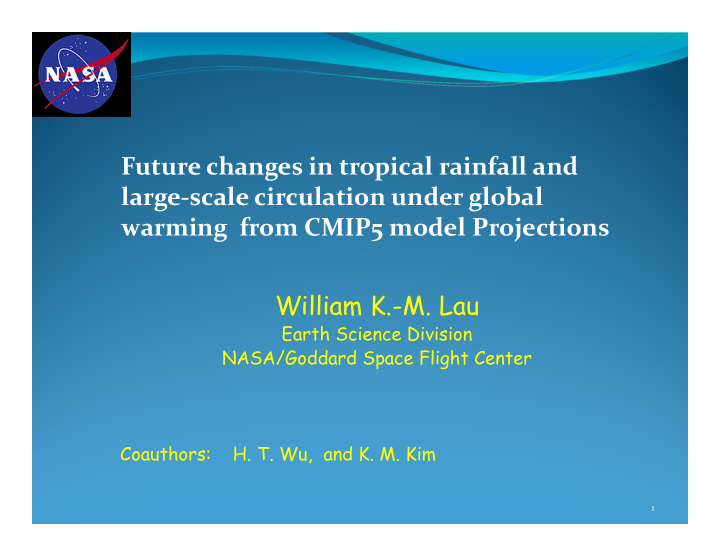



Future changes in tropical rainfall and large-scale circulation under global warming from CMIP5 model Projections ����������������� ���������������������� ���������������������� ���!����� !��������"����#��$����%��������������� 1
The Yin-Yang (floods and droughts ) and the Chi (Hadley Circulation) of the Global Water Cycle Lau and Kim, 2012: The Russian heat wave and Pakistan flood 2010: A teleconnection of hydroclimate extremes.. J. Hydro. Meteor. 2 Lau et al. 2013: A Canonical Response of Rainfall Characteristics to Global Warming, Geophys. Res. Lett.
Excerpts from IPCC AR5 : It is likely that since about 1950 the number of heavy precipitation events over land has increased in more regions than it has decreased. Regional trends vary but confidence is highest for central North America with very likely trends towards heavier precipitation events,…….. the frequency and intensity of drought has likely increased in the Mediterranean and West Africa and likely decreased in central North America and north-west Australia since 1950 . It is likely that circulation features have moved poleward since the 1970s, involving a widening of the tropical belt, a poleward shift of storm tracks and jet streams, and a contraction of the northern polar vortex. Evidence is more robust for the Northern Hemisphere. It is likely that the Southern Annular Mode has become more positive since the 1950s. Confidence is high that the increase in the northern mid-latitude westerly winds and the NAO index from the 1950s to the 1990s and the weakening of the Pacific Walker circulation from the late 19th century to the 1990s have been largely offset by recent changes. . 3
Monsoon Climate Change as inferred from CMIP5 Multi-Model Mean (MMM) 33 CMIP5 coupled models, future projection - 1% per year increase in CO 2 emission (140 yrs starting at present climate) Control = 1 st 25 year of integration MMM anomaly = last-25-years minus Control (TCO2 ) • 17 CMIP5 coupled models (1900-2005), 20 th Century Historical runs a) Control (pre-industrial conditions + natural)) b) All ( GHGs + anthropogenic aerosols +natural) c) GHGs only (GHGs + natural) d) Nature run (solar change, volcanic eruption…)
Global temperature Global Rainfall 2–3.6 K century -1 1.35± 0.38 % K -1 DCO2 TCO2 Yr 71-97 Yr 114-140 5
Meridional profiles of rainfall response (ensemble mean difference) to global warming at different longitudinal sectors from CMIP5 50E-140E 140E-130W Asian-Australia Central /Eastern Pacific 40W-130W 40W- 50E Euro-Africa Americas 6
A canonical global rainfall response: more heavy rain , less moderate rain , more light rain and more no-rain occurrence NR LR MR HR VHR 7
A loaded climate dice Heavy Rain (>98 perentile) anomaly Prolonged dry-month anomaly Increased risk of heavy rain, and prolonged period of drought due to CO2 warming are connected, occurring in preferred geographical locations, through changes in the large-scale circulation. 8 Lau et al. 2013, GRL.
A prevailing view about the changes in the tropical circulation under global warming Globally E=P = qM M= vertical mass flux at cloud base; q= moisture at cloud base dM/M = dP/P - dq/q = 1.35 – 6.5 = -5.15 % K -1 < 0 === > Weakening of the tropical circulation, i.e., the Walker and Hadley Circulations (Held and Soden 2006, Vecchi and Soden 2008…..) 9
A Conundrum : How can a weakened tropical circulation, particularly the Hadley Circulation compatible with increased latent heat due to enhance rainfall in the tropics under global warming? The fundamental question: Is the Hadley Circulation weakened or strengthened under global warming?? 10
Time variation of zonal mean W500 as a function of spatial scales CMIP5 1% per year CO2 increase Equatorial Tropics/ Region Subtropics/ Midlatitudes Tropics/ Deep Tropics Subtropics/ Mid-, High-latitudes Tropics Near Global Tropics/ Global Subtropics 11
-Narrowing Convective Zone in deep tropics - Expanding subtropics - Poleward shift of Ferrel and polar cells
Enhanced W Ascent T C Deeper Clouds
Global warming raised the HC outflow region, intensifying the upper branch of the HC
Time-height cross-section of meridional winds , at 10N and 10S under global warming total (contour) and anomalies (color) Rate of total div. Mass outflow At 200-100 hPa +10% K -1
∆ P ∆ U 18
MC/WPAC EPAC Walker Circulation (MC/WPAC Minus-EPAC) ~ 20% reduction
Pre-industrial Climate Δ T > Δ T S Global warming Δ H T >0 Climate Weakening/polar shift of polar jet?? Stronger, deeper, narrower Convective zone δ Div Vq >0 Δ -V· q>o Δ T S > 0 ΔC >0 ΔC <0 , Δ q <0 ΔC >0 Δ q>0 Δ S m <0, Δ E<0 Δ q>0 20 +ve feedback over land Δ E >0
Back -Up 21
Zonal mean SSTA removed 22
23
Deeper convection/clouds in near equatorial regions 26
Recommend
More recommend